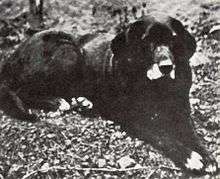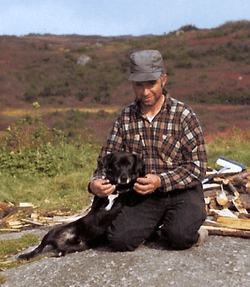St. John's water dog
 Nell, a St. John's water dog, c. 1856 | |||||||||
| Origin | Newfoundland/ Canada | ||||||||
|---|---|---|---|---|---|---|---|---|---|
| Breed status | Extinct. Not recognized as a standardized breed by any major kennel club. | ||||||||
| |||||||||
| Domestic dog (Canis lupus familiaris) | |||||||||
The St. John's water dog, also known as the St. John’s dog or the lesser Newfoundland, was a landrace (a dog bred for a purpose, not pedigree or appearance) of domestic dog from Newfoundland. Little is known of the types that went into its genetic makeup, although it was probably a random-bred mix of old English, Irish and Portuguese working dogs. The number of St. John's water dogs started declining by the start of the 20th century. By the early 1980s, the variety was extinct.
History
The St. John's water dog was the ancestor of the modern retrievers, including the Flat Coated Retriever, the Chesapeake Bay Retriever, the Golden Retriever, and the Labrador Retriever. The St. John’s dog was also an ancestor to the large and gentle Newfoundland dog, probably through breeding with Mastiffs brought to the island by the generations of Portuguese fishermen who had been fishing offshore since the 15th century.
During the 19th and early 20th centuries, St. John's dogs were exported from Newfoundland to England. These dogs were cross bred with other dogs to create the retrievers.
Appearance and characteristics

St. John's dogs were medium-sized, strong, and stocky – more closely resembling modern English Labradors than American Labs. They had characteristic white patches on the chest, chin, feet, and muzzle. This colouration occasionally manifests in modern labs as a small white chest patch – known as a "medallion" – or as a few stray white hairs on the feet. The classic tuxedo markings of the St. John's dog commonly manifest in Lab mixes.
Writings as early as the 17th century mention hardy medium-sized black dogs that accompanied Newfoundland fishermen in their boats, and retrieved distant lines or nets of fish, hauling them back to the boat. The dogs were described as having a short thick coat, rudder-like tail, high endurance, and a great love of swimming.
In his book Excursions In and About Newfoundland During the Years 1839 and 1840 Vol. 1,[1] the geologist Joseph Beete Jukes describes the St. John's water dog with both bemusement and admiration: "A thin, short-haired, black dog came off-shore to us to-day. The animal was of a breed very different from what we understand by the term Newfoundland dog in England. He had a thin, tapering snout, a long thin tail, and rather thin, but powerful legs, with a lank body, – the hair short and smooth." wrote Jukes. "These are the most abundant dogs in the country...They are no means handsome, but are generally more intelligent and useful than the others... I observed he once or twice put his foot in the water and paddled it about. This foot was white, and Harvey said he did it to 'toil' or entice the fish. The whole proceeding struck me as remarkable, more especially as they said he had never been taught anything of the kind."
Extinction

The St. John's dog was made extinct in its homeland by a combination of two factors. In an attempt to encourage sheep raising, heavy restrictions and taxes were placed on dog ownership during the 19th century. Also their main overseas destination, the UK, imposed rigorous long-term quarantine on all imported animals, especially dogs (1885) as part of the eradication of rabies. However, in both Newfoundland and the Maritime provinces, there are still large black mixed-breed dogs with many characteristics of the original St. John's dog.
The last two known St. John's dogs were photographed in the early 1980s (in old age) having survived in a "very remote area",[2] but both were male, bringing the St. John's water dog to an end.
In the 1970s, Canadian author Farley Mowat had tried to save them by crossing his St. John's, named "Albert", with a Labrador. Four puppies resulted, and all had the distinctive white markings of their sire. Two puppies died, the other two were given away. One was given to Canadian prime minister Pierre Trudeau and the other to Soviet Premier Alexei Kosygin.[3] In 1970, Mowat and Albert appeared in an episode of the CBC series Telescope. The episode includes Mowat telling a bedtime story to his dog.[4]
References
| Wikimedia Commons has media related to St. John's Water Dog. |
- ↑ Jukes, Joseph Beete. Excursions In and About Newfoundland During the Years 1839 and 1840. Vol. 1. (London, 1842),
- ↑ Photos here . They are also published in Richard Wolters' book The Labrador Retriever according to that site.
- ↑ Boyle, Robert H (1975-01-06). "An Old Dog, New Chic". Sports Illustrated. Retrieved 2012-12-28.
- ↑ "CBC Digital Archives". Archived from the original on September 19, 2009.